Watch the Webinar
Discover the latest findings from the Global IT Experience Benchmark H2/2022
In total, 1,642,555 end-user responses in over 130 countries were collected and analyzed in 2022. In this report, we focus on Overall IT Experience of enterprise end-users and IT Experience Management maturity among our customers.
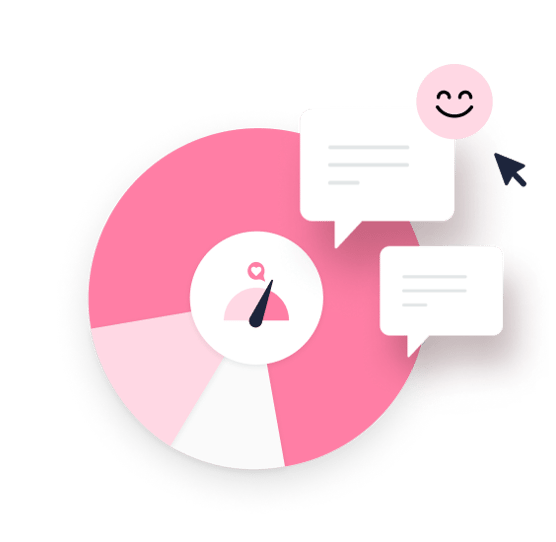
If you're a CIO, IT Leader, Experience Owner, or Service Owner wanting to make informed decisions based on experience data, this report is for you.
IT Support services have the most significant impact on the Overall IT Experience of end-users
The key benefits of IT Experience Management are happier end-users, focused IT teams, better decisions, and more motivated IT employees
Fewer sanctions are linked to service desk KPIs than two years ago
More than 30% of companies have or plan to start creating an Experience Management Office (XMO)
Service Portal happiness has increased +22 points in the last year.
1. How happy are end-users with different IT touchpoints?
Insights about the global IT experience for Enterprise end-users across different touchpoints.
2. Overall IT Experience - the reputation of IT?
3. Geographical Differences in IT Happiness
4. IT Experience Management maturity
5. IT Service Desk Benchmarks data
5.1 IT incidents
5.2 IT incident factors for happiness
5.3 IT incident channel distribution
5.4 Ticket reassignments
5.5 IT Support Profiles
5.6 IT Requests
5.7 IT Request channel distribution
5.8 IT Request factors for happiness
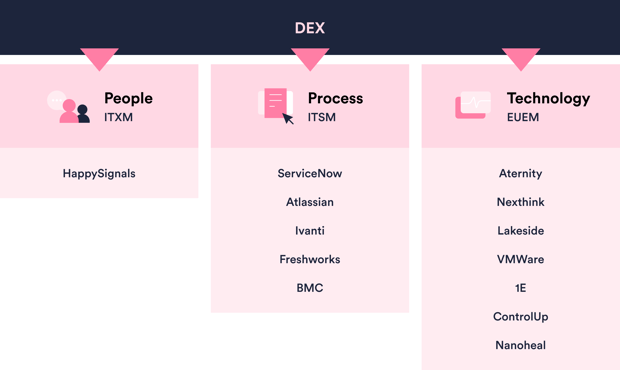
The Global IT Experience Benchmark H2/2022 Report presents and analyzes data from 1,642,555 end-user responses collected through the HappySignals IT Experience Management Platform between January-December 2022.
On this webpage, we mainly included the 2022 data and a few selected trends across time (from before H2/2022).
Our benchmark data is collected from all HappySignals customers. These include large enterprises, as well as Managed Service Providers (MSP) who use the HappySignals Platform with their customers – enterprises and public sector organizations.
About 60% of HappySignals customers are using Outsourced Service Desk providers.
All responses are from IT end-users – employees using internal IT services – and reflect their feelings and perceptions about IT.
HappySignals IT Experience Management Platform connects operational data (e.g. from customers’ ITSM platforms) with continuous survey data from end-users about Ticket-based IT and Proactive IT areas.
Ticket-based IT (Incidents and Requests):
End-user responses are collected immediately when tickets are resolved. Surveys are sent after each ticket, asking end-users to accept the resolution by giving feedback about their experience. The average response rate for HappySignals customers is around 25-30%.
Proactive IT:
Surveys are sent proactively to end-users about Proactive IT areas (e.g. Overall IT Experience, Enterprise Applications, Laptops and Computers, Remote Work, Office Environment), rather than in connection with tickets. These surveys can be scheduled to target relevant end-users at optimal frequencies, enabling continuous measurement of non-ticket-based IT areas.
Data about IT Experience Management Maturity and ways of working:
This report includes some analysis of ITXM maturity among HappySignals customers. This data was collected through a separate survey that we sent to our customers in January 2023. The data contains answers from enterprise IT professionals. The survey was not sent to representatives of outsourced IT service providers on this occasion.
Happiness:
End-users rate how happy they are with the IT area being measured (e.g. recent ticket-based service experience, Enterprise Applications, Mobile Devices, etc) on a scale from 0-10.
HappySignals then calculates: % of 9-10 scores - % of 0-6 scores = Overall Happiness (a number between -100 to 100).
Productivity:
End-users estimate how much work time they lost due to the IT area being measured.
Factors:
End-users select from a list of suggested reasons – which we call Factors – that influenced their Happiness rating. Multiple factors can be selected.
The surveys automatically tailor the factors shown to each end-user depending on what IT area is being measured, and whether the Happiness rating given in the first question was positive, negative, or neutral. Examples of factors include “It was difficult to know where to start” (Ticket-based Services) and “Applications are too slow” (Enterprise Applications).
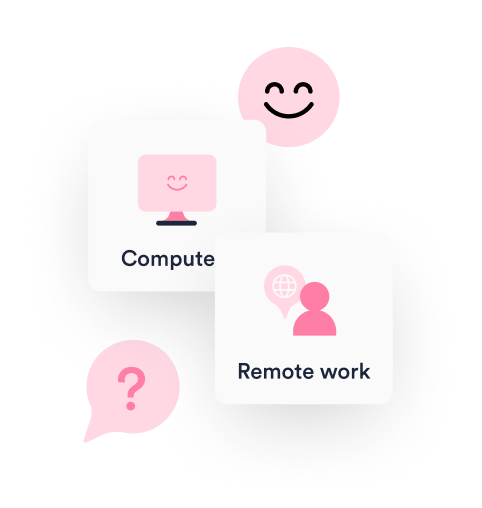
IT Happiness across all measurement areas
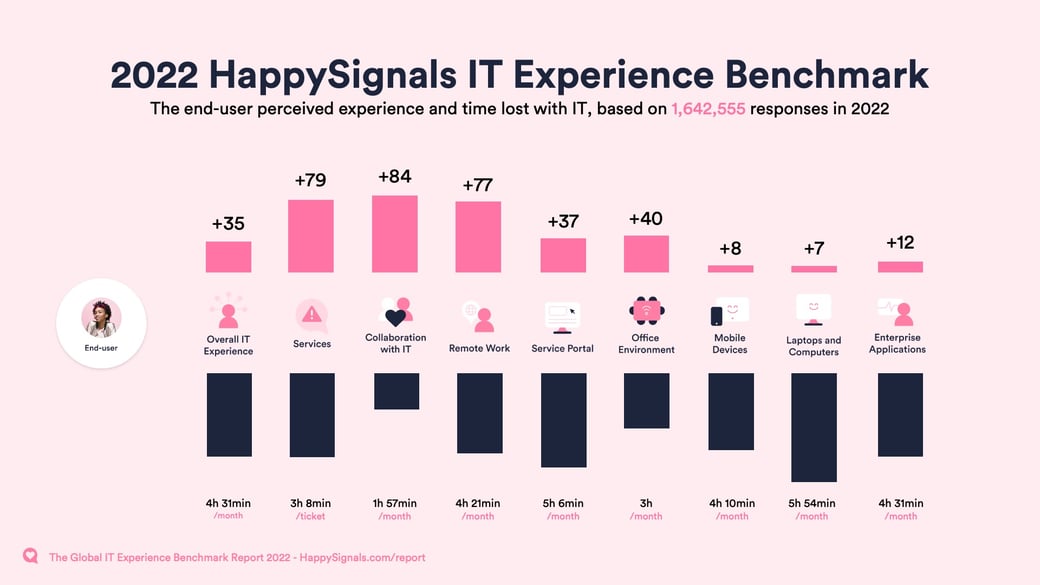
| Measurement Areas | 2021 Happiness | 2022 Happiness |
| Overall IT Experience | n/a | +35 |
| Services | +77 | +79 |
| Collaboration with IT | +82 | +84 |
| Remote Work | +64 | +77 |
| Service Portal | +15 | +37 |
| Office Environment | n/a | +40 |
| Mobile Devices | -4 | +8 |
| Laptops and Computers | +13 | +7 |
| Enterprise Applications | +16 | +12 |
NB! Numbers may vary from the last report due to data quality improvements, which have been applied to historical data as well for better comparability. Scores are calculated with the same mathematical model as NPS. (Read about What is the difference between NPS and HappySignals?)
What is the business impact of ITXM on Overall IT Experience?One of the common mistakes is assuming which IT touchpoints make IT end-users happy. However, new customers are often surprised by the touchpoints that are highly rated by their end-users. Contrary to popular belief, IT services are frequently among the most highly rated IT areas. If the goal is to enhance the overall employee experience with digital technologies, it's crucial to be aware of which areas are liked the most and the least. Real-time experience data across different IT touchpoints provides valuable insights that facilitate conversations between IT, HR, and business functions. Having a comprehensive understanding of the IT experience enables the company to allocate resources based on employee feedback data rather than the gut feelings of leadership team members. This, in turn, leads to a higher success rate in digital transformation projects. |
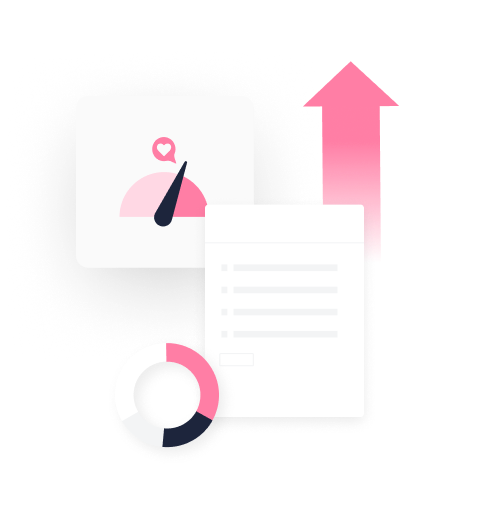
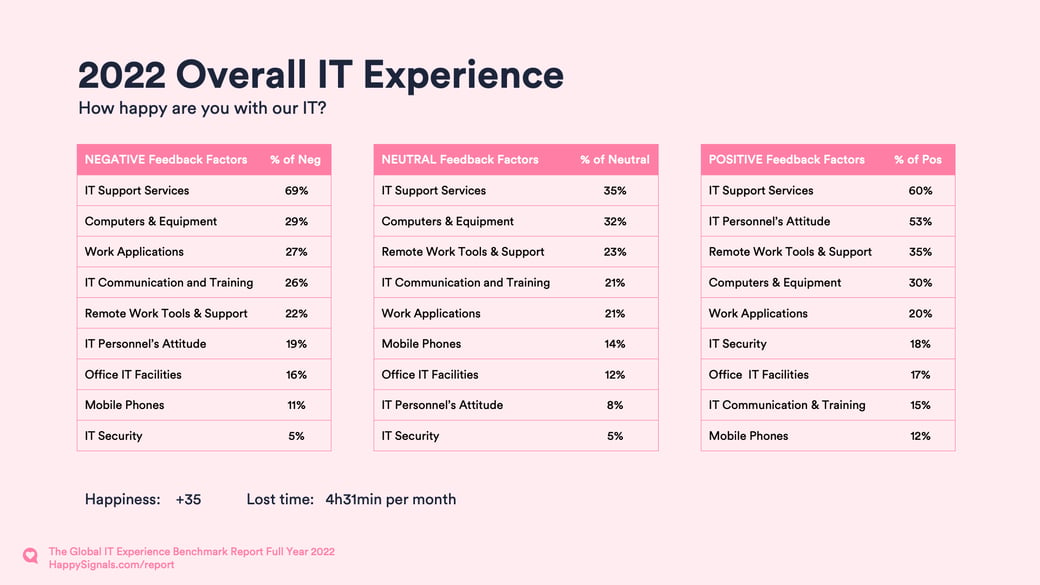
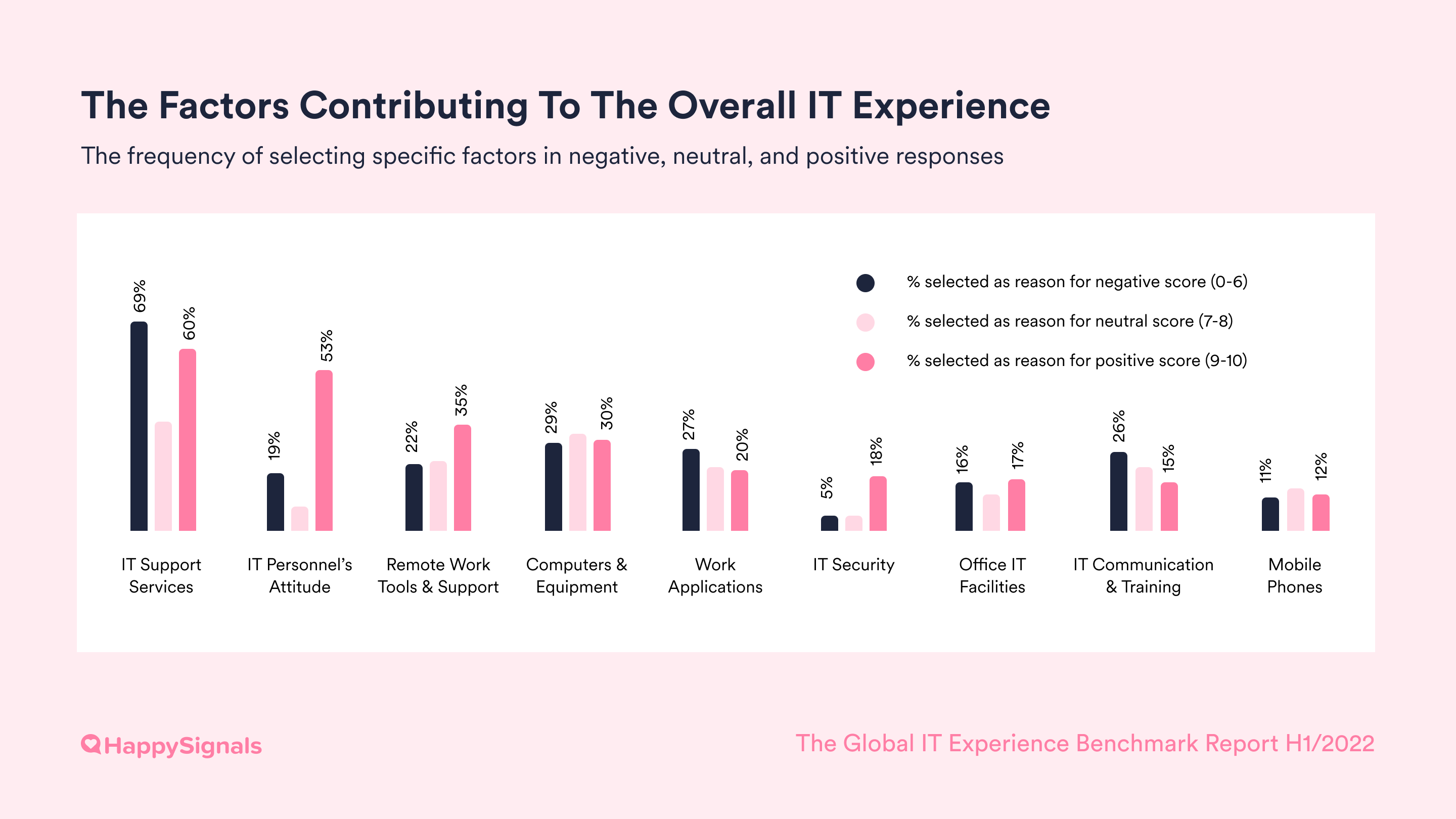
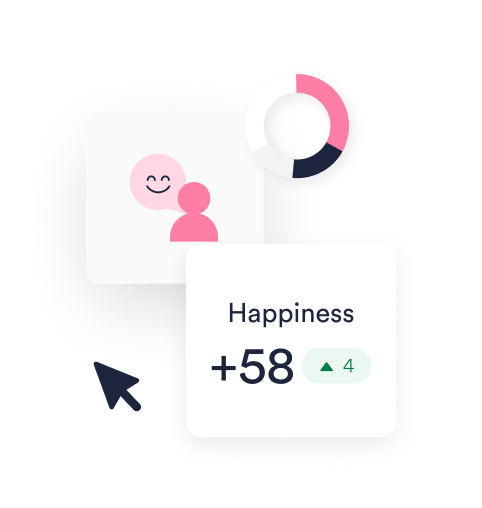
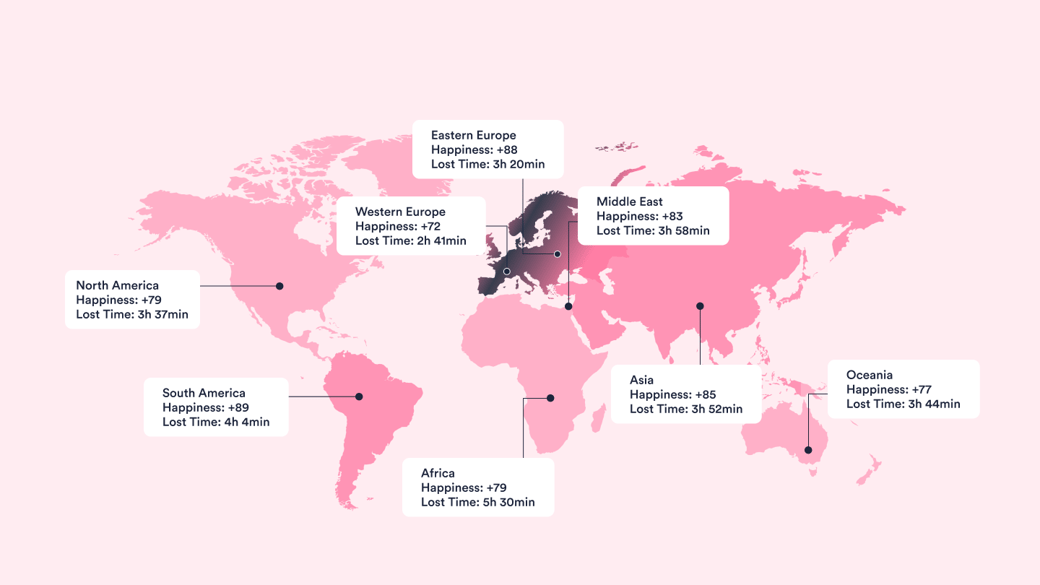
Differences between regional differences for incidents and requests
We observe interesting regional differences between how the numbers vary between incident and request Happiness and Lost Time.
These numbers appear to suggest that Western European end-users are more demanding in handling incidents, but North American end-users have higher expectations for requests.
We’ll continue to track these numbers and report more in-depth in future reports.
Findings for regional differences for experience with resolved requests
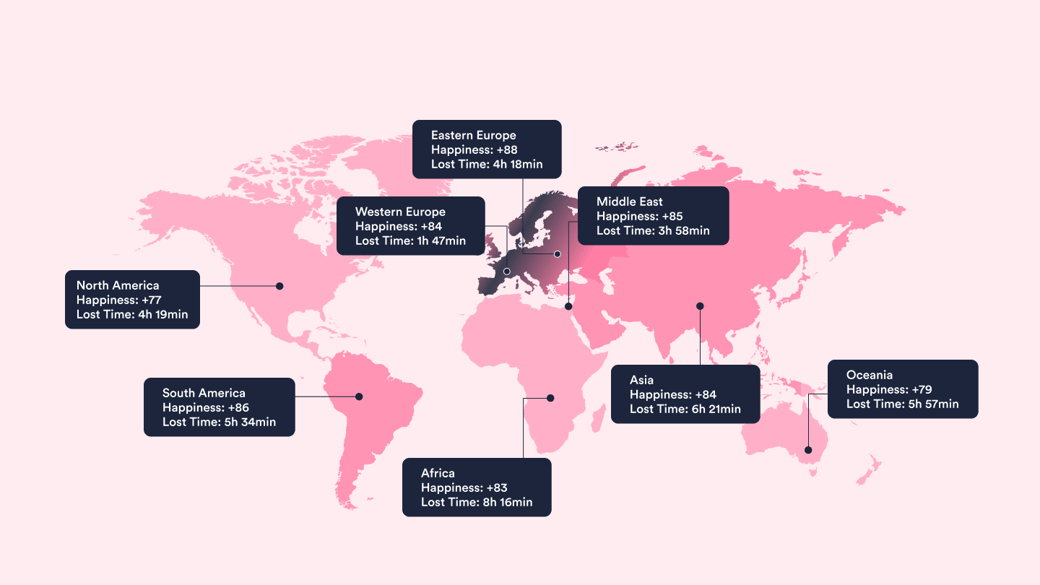
Different cultures perceive and evaluate IT services in different ways. A specific score in one region is not directly comparable to the same specific score in another region. Having comparable benchmark data helps set expectations and provides an external angle for better understanding of end-user experience.
How to use this information in practice?IT service desk leaders can compare the scores to the country benchmark data to choose which countries to focus on. Using the comparison to benchmark data (in addition to internal averages) can help avoid pushing agents towards unachievable goals, or reversely avoid getting too comfortable in regions where higher scores are culturally more common. |
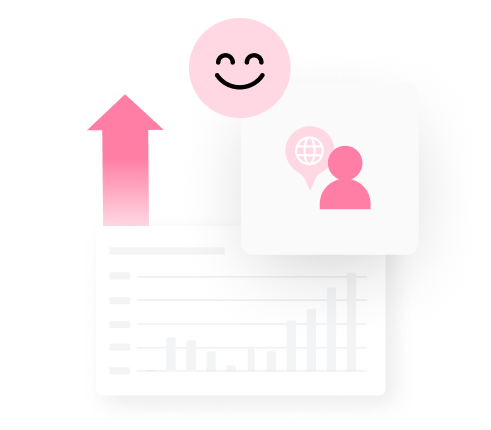
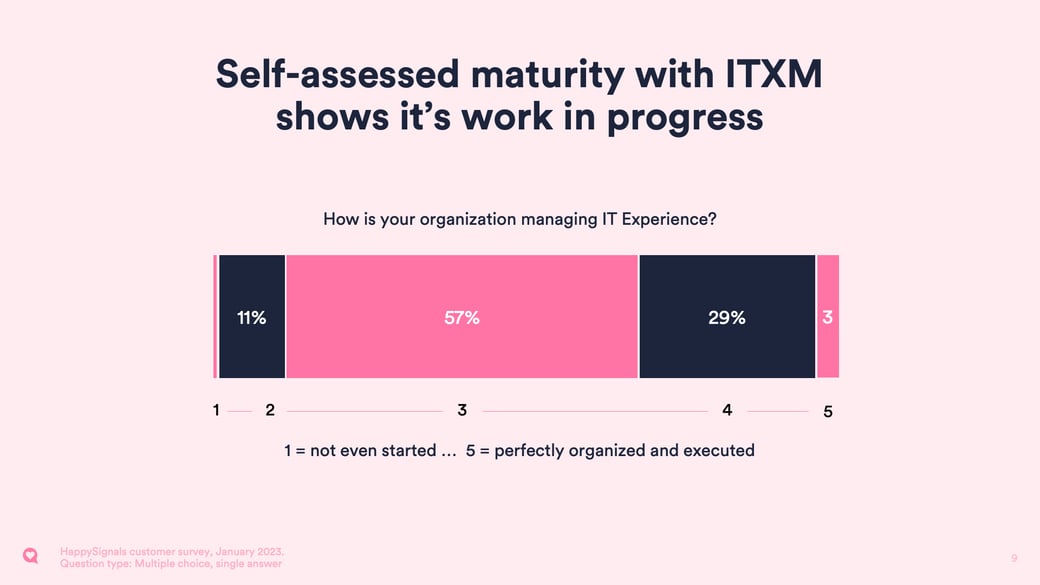
Most respondents felt their organization is still on the journey towards being perfectly organized and executed. This is expected as ITXM practices are still new and often require changing previously established practices and processes.
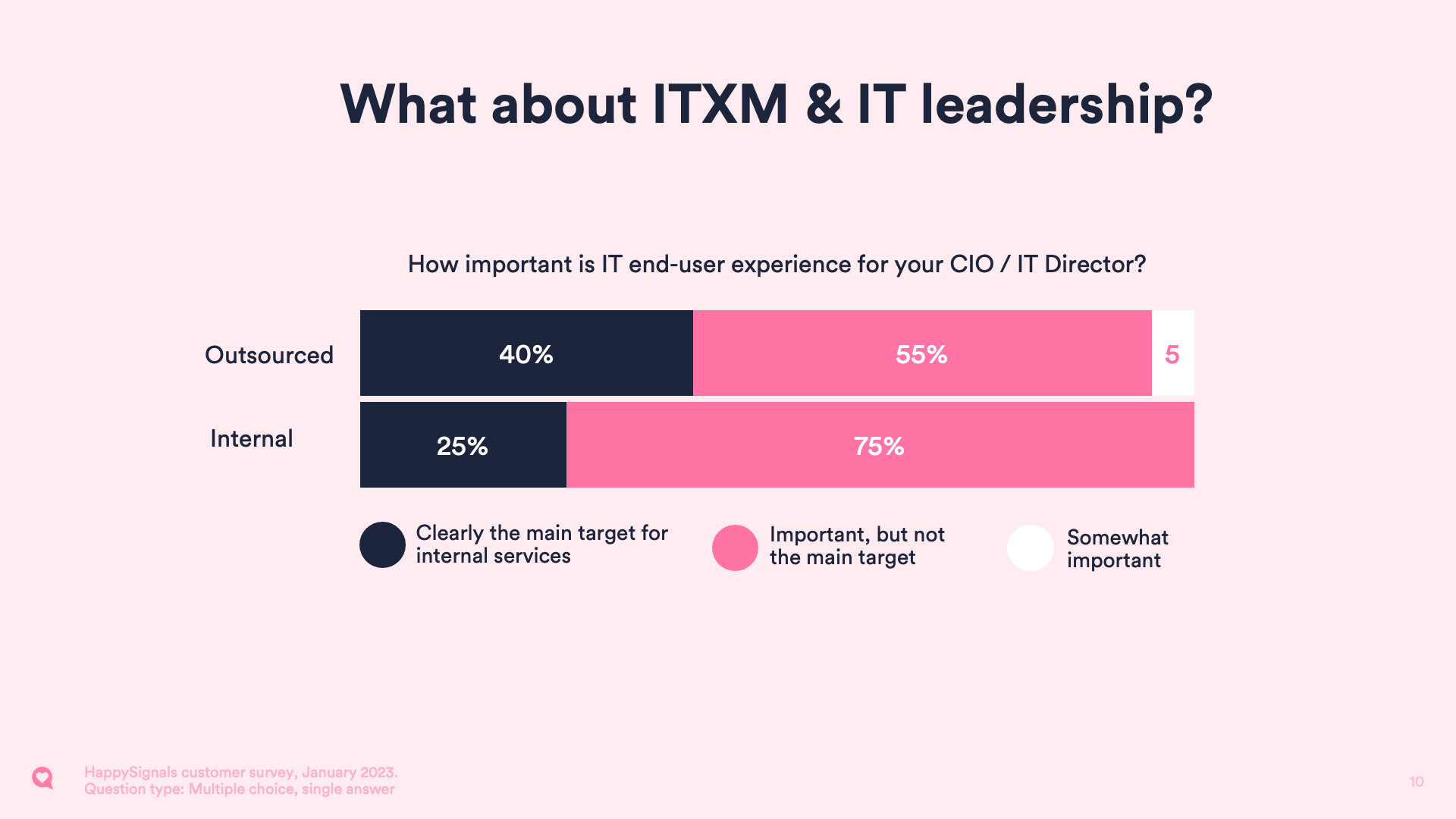
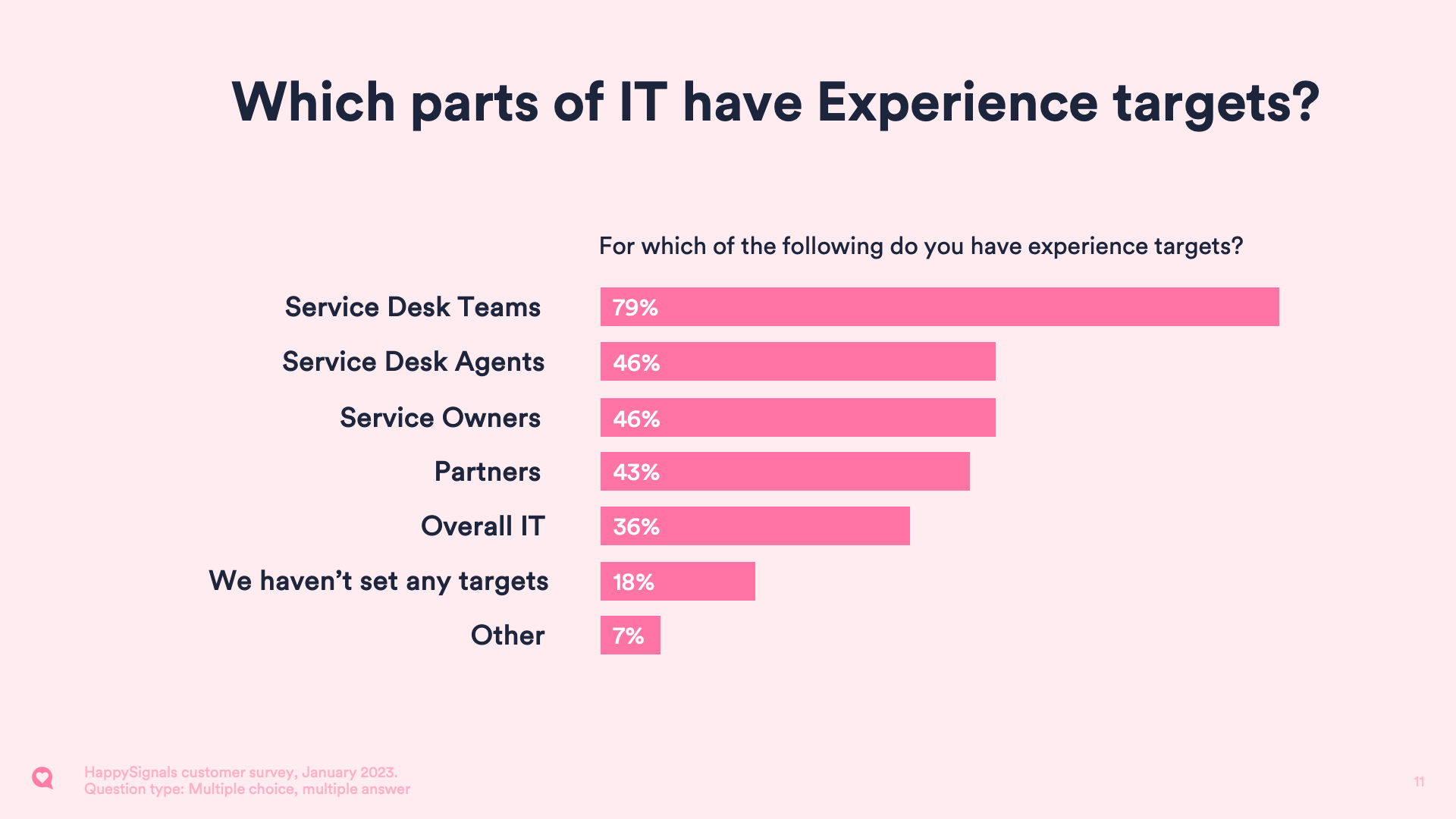
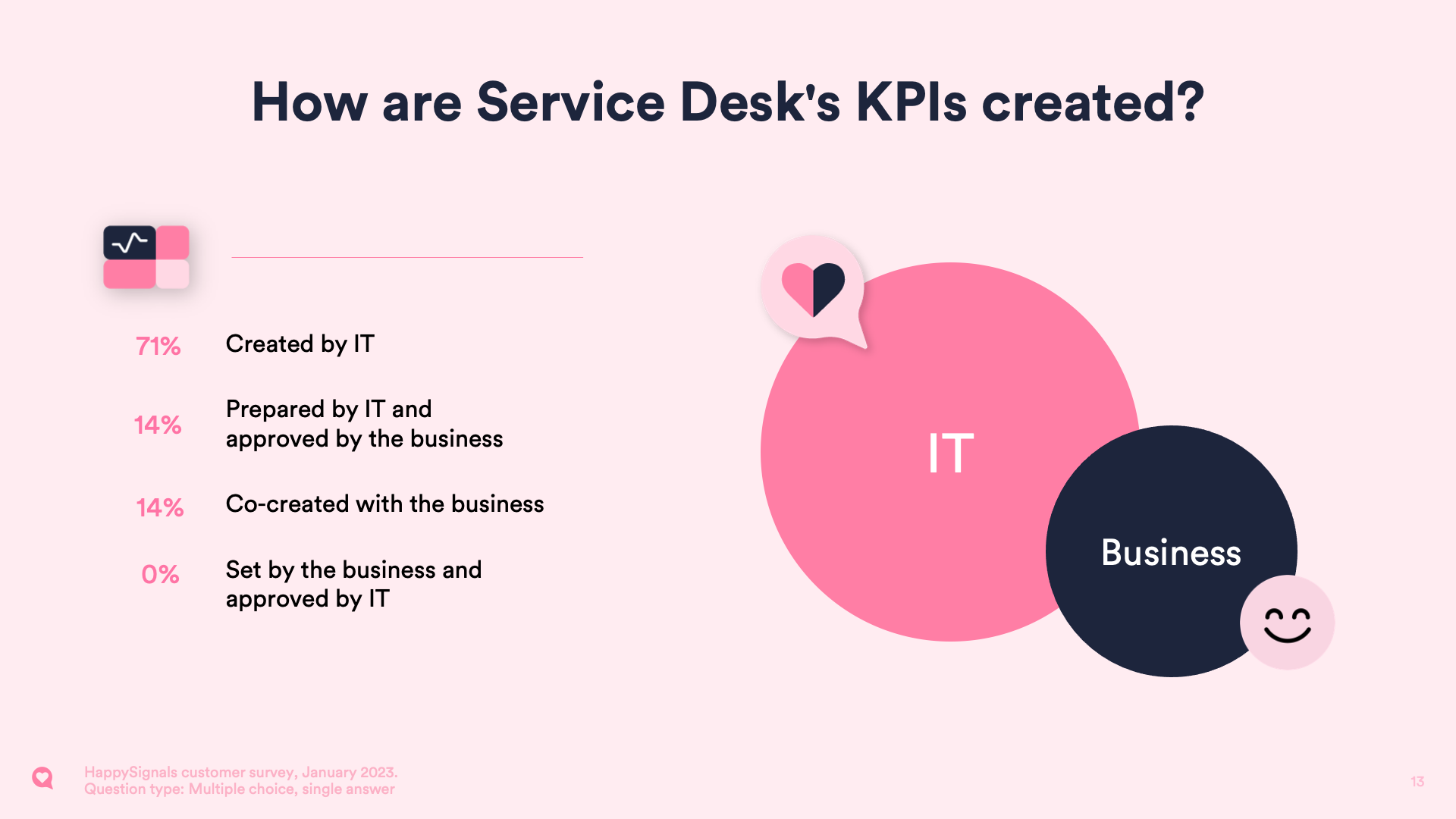
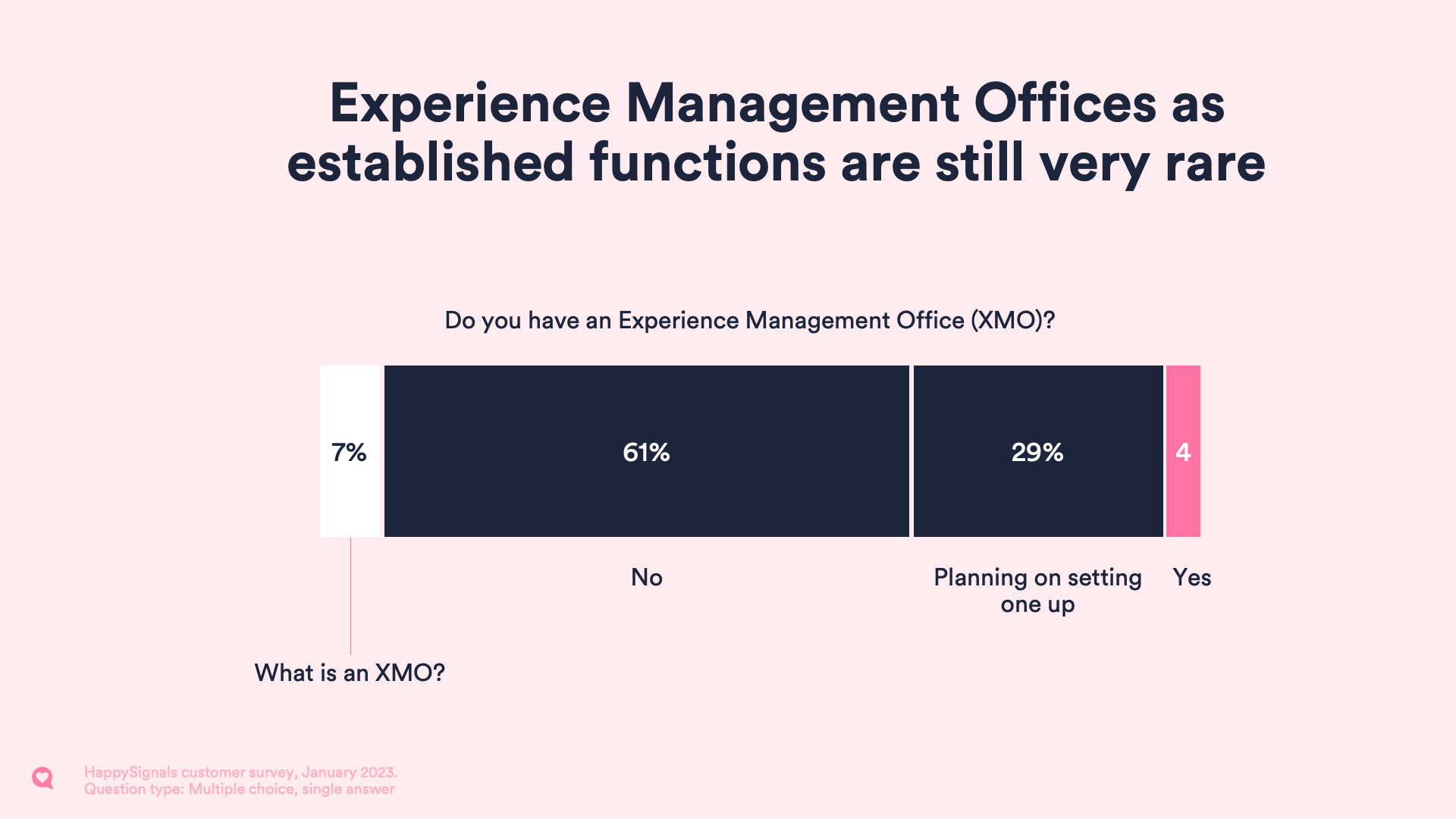
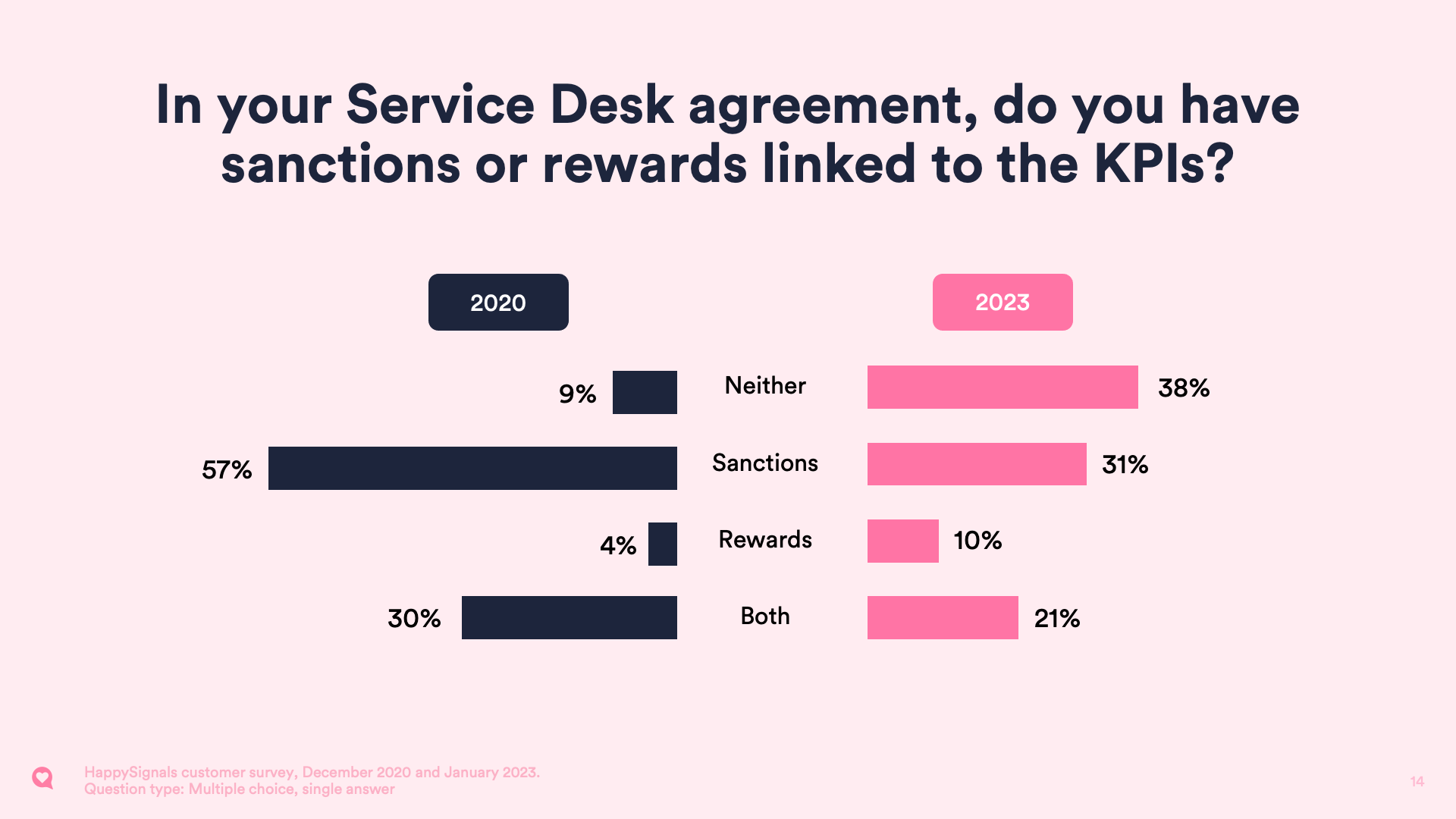
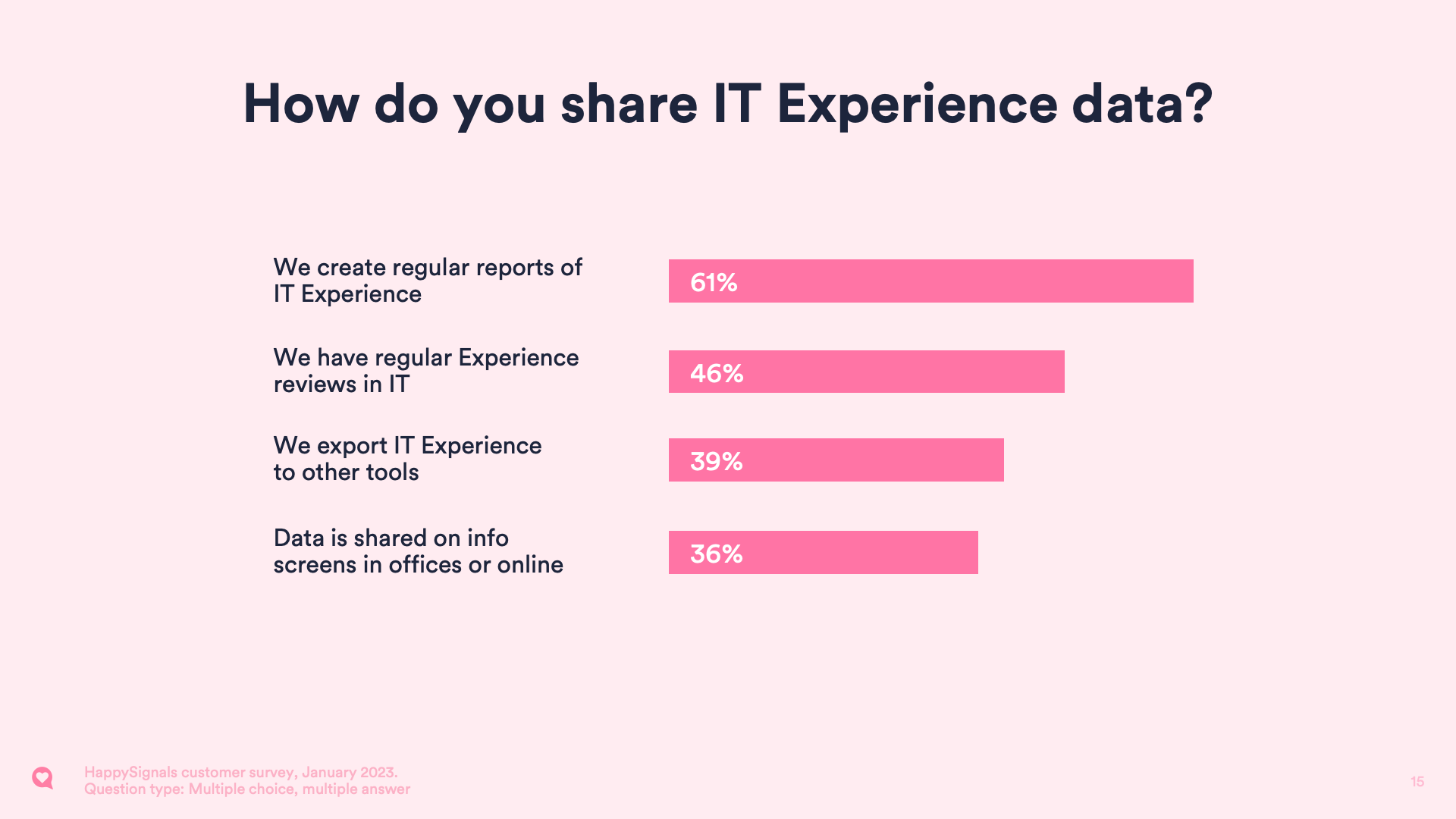
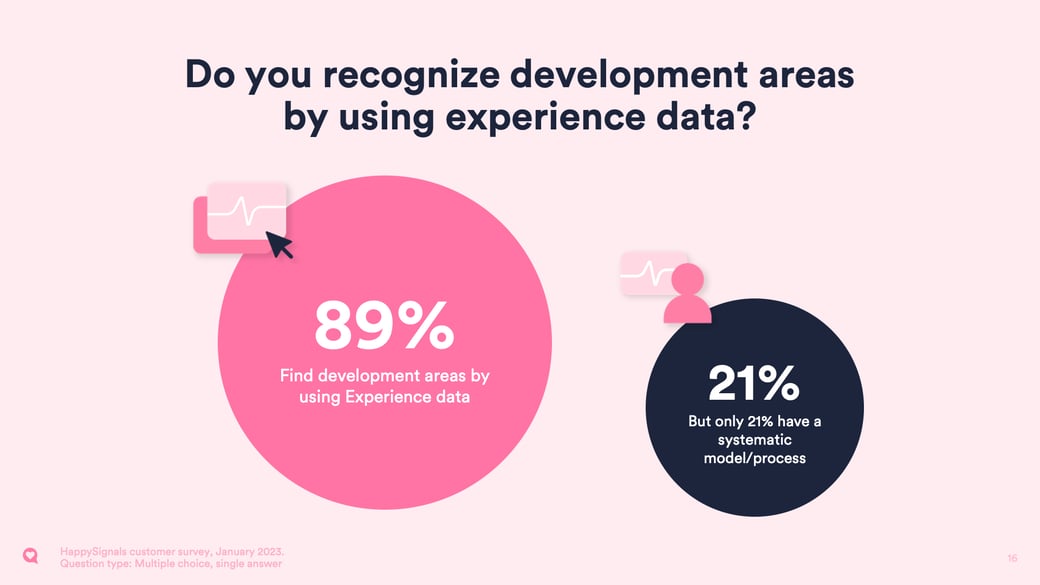
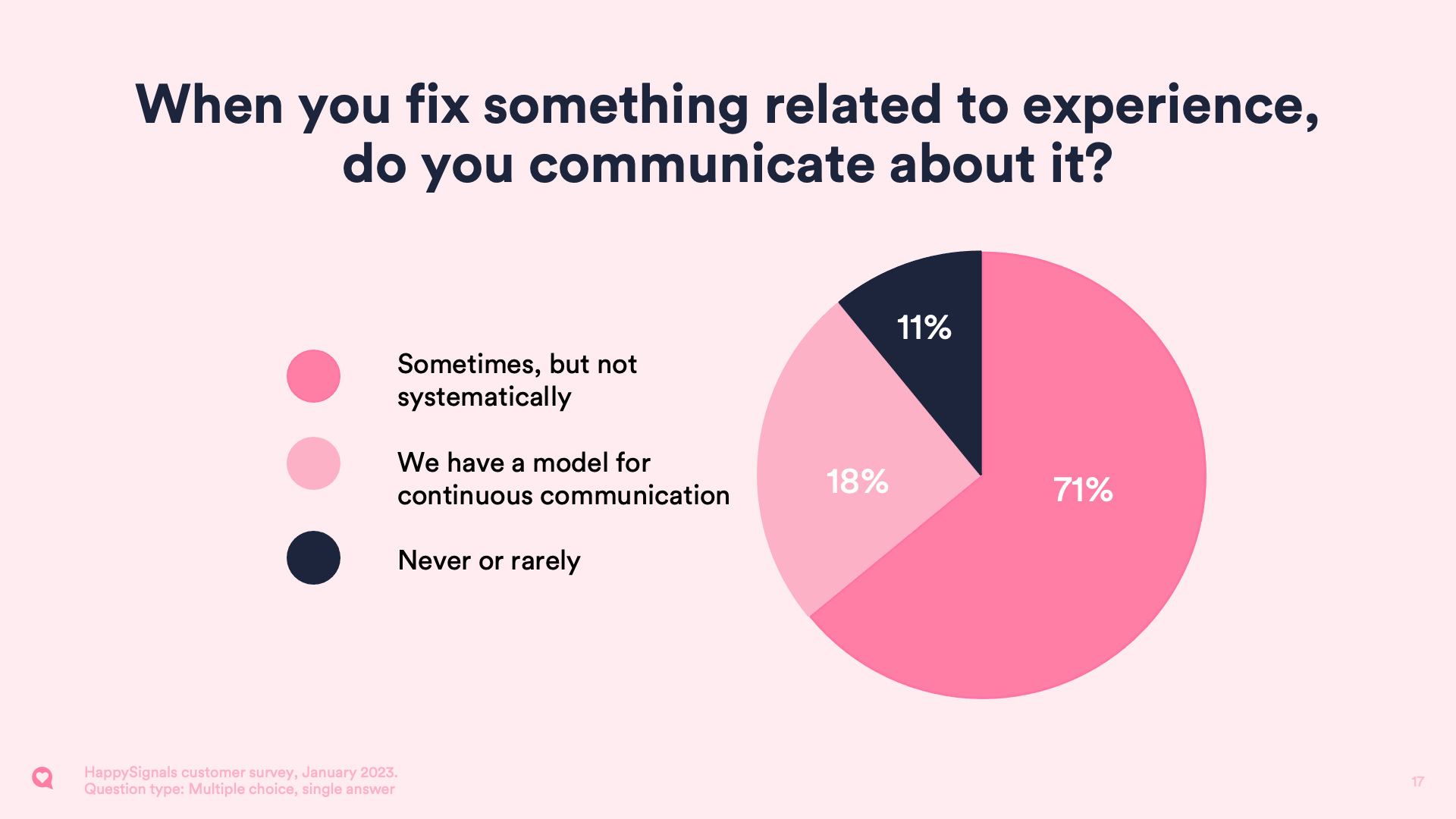
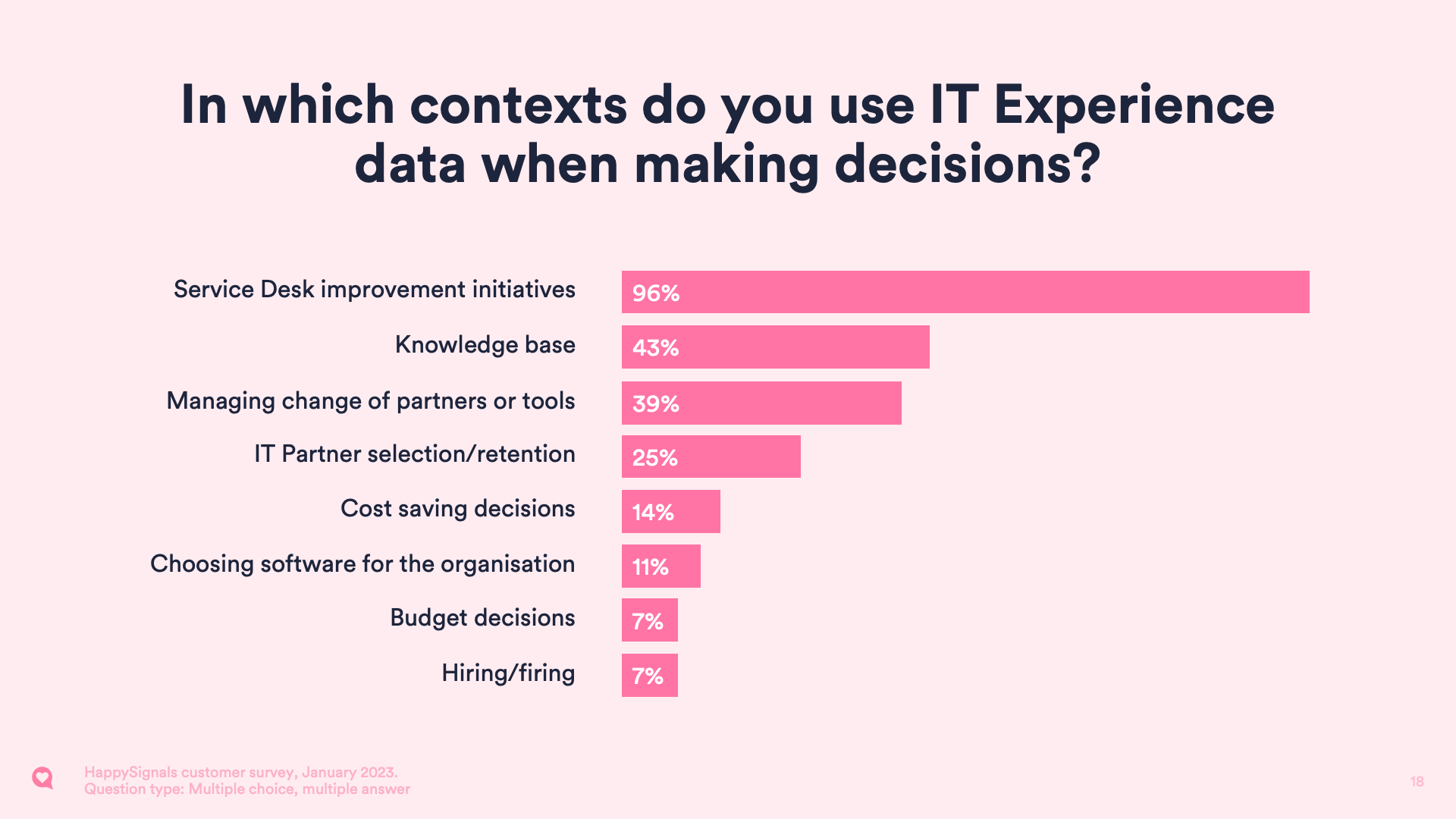
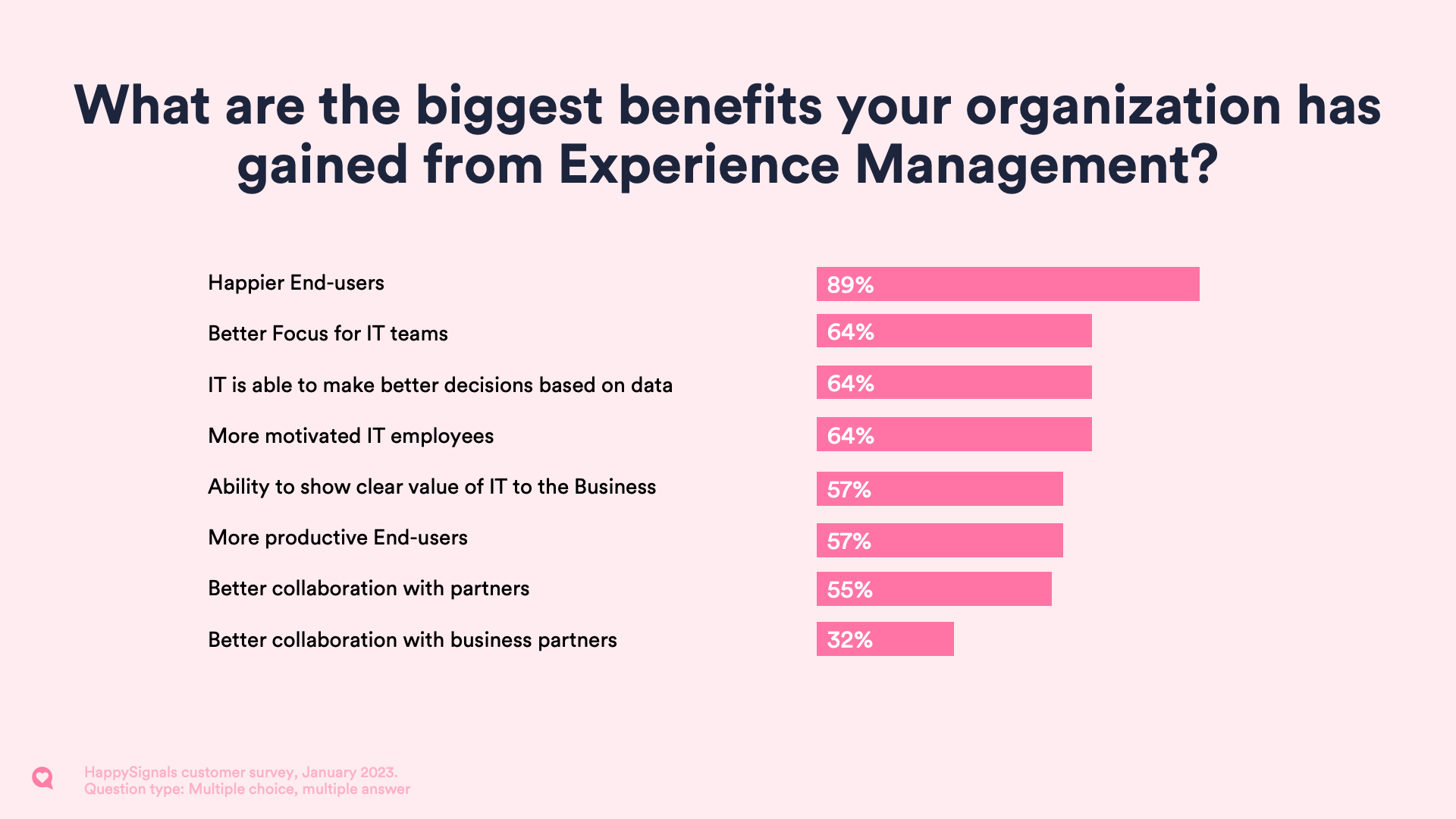

The upward trend over several years with IT incident resolutions happiness has stabilized. Lost time with IT incidents is slightly oscillating but al in all, the changes in 2022 were minor.
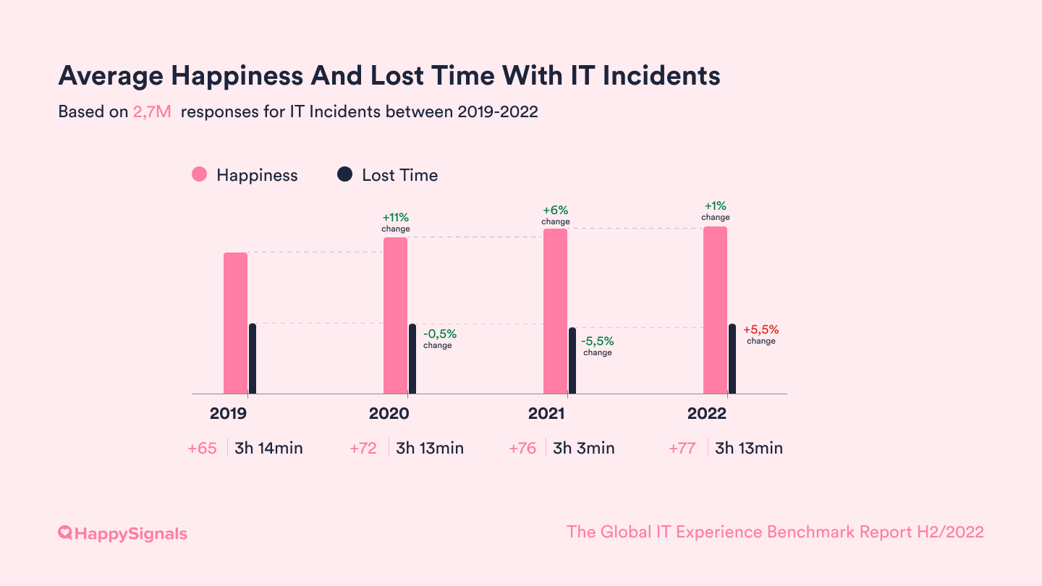
The data below was first reported in the H1/2022 Benchmark report, but is still very relevant. The section below is identical to the previous report.
Looking more closely at lost time across all incidents, we can see that the distribution of perceived lost time is unevenly represented on both sides of the spectrum. The historical trend shows how this polarization of the speed of service means that tickets solved in under 8 hours are solved even faster year after year, but tickets that lead to more than 8 hours of lost time take even longer.
This explains the paradox of rising average lost times in the last two reports. Most end-users are receiving faster IT support with IT incidents, but those that do not have to wait an increasingly long time. This leads to average lost time going up due to the even longer waiting times for the tickets that lead to more than 8 hours of perceived lost time.
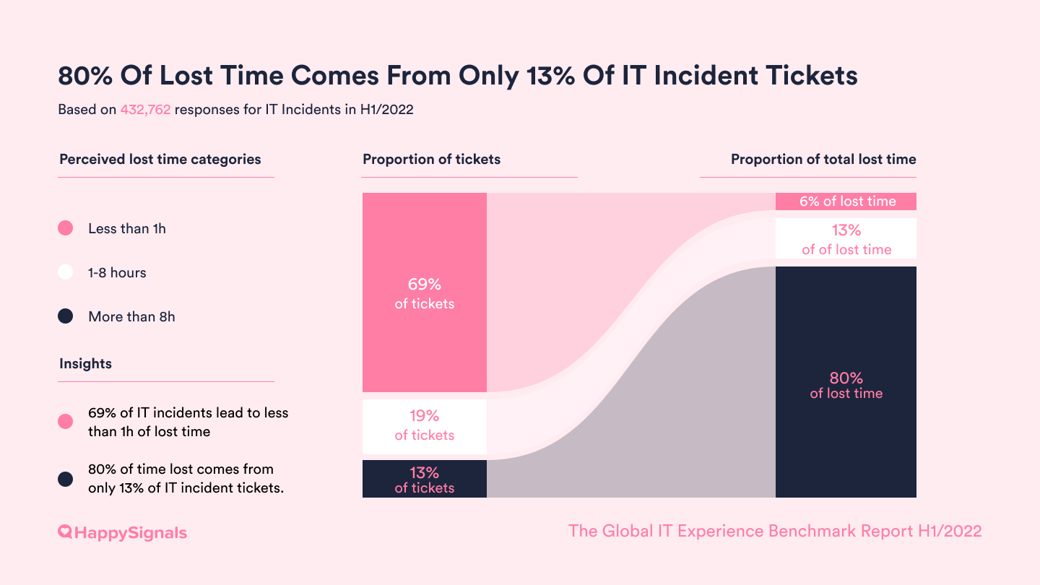
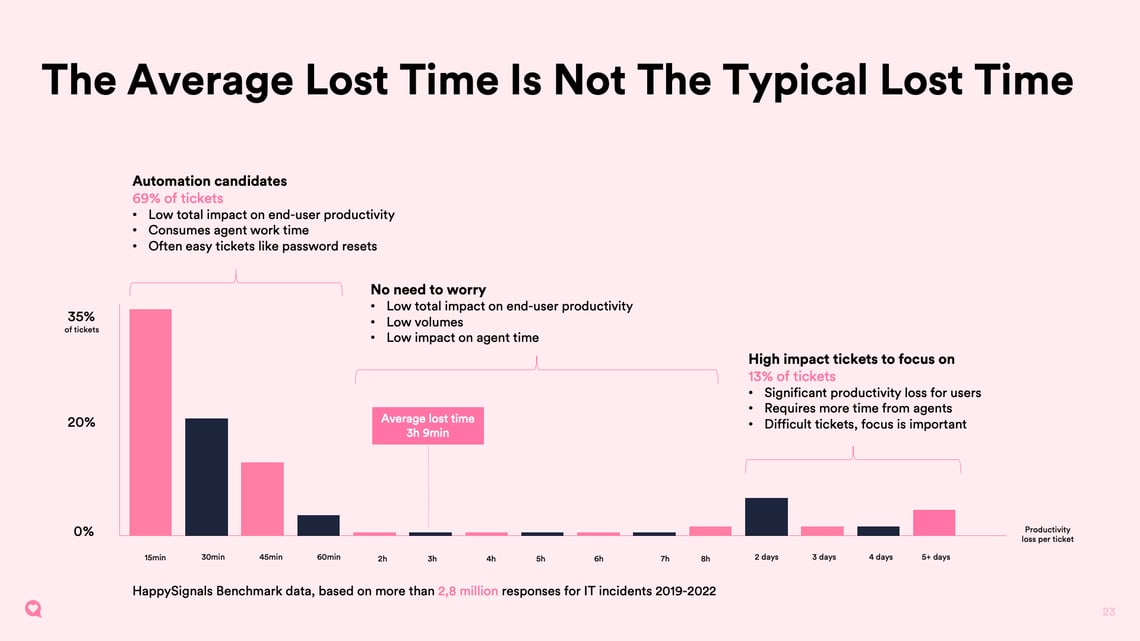
Understanding the reasons behind end-users' dissatisfaction with ticket-based IT services is crucial for improving them, and the HappySignals IT Experience Management Platform excels in identifying these factors.
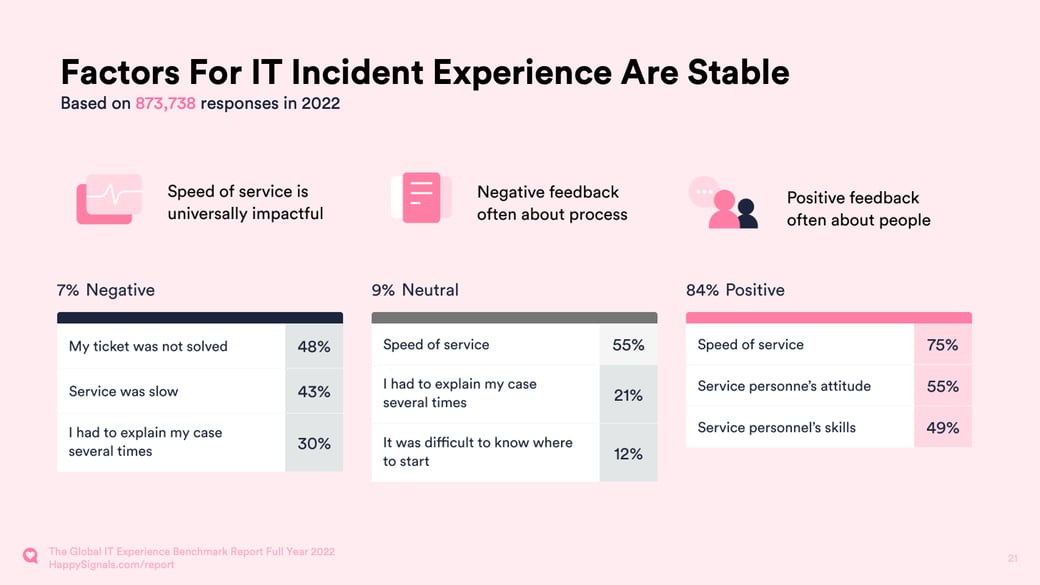
Using a standardized list of Factors developed from research with IT end-users, we ask end-users to select the factors that best reflect their satisfaction or dissatisfaction with the service in a survey sent to them after a ticket resolution. The timing of the survey delivery is optimized to assess end-users' feelings about the service at the moment of their experience, making our Factors data more reliable.
Different factors are presented to end-users depending on their happiness rating on a 10-point scale, and they can select as many factors as they wish from the list. Factors related to service agents are included in all three scenarios of negative (0-6), neutral (7-8), and positive (9-10) experiences. For example, for IT incidents, 75% of responders who gave a positive happiness rating and selected at least one factor were happy about the speed of service.
End-users can select multiple factors, thus making the percentages add up to more than 100%. By monitoring and analyzing these factors, IT organizations can gain valuable insights into end-user satisfaction and identify areas for improvement in their ticket-based services.
The factors that create positive, neutral and negative experiences with IT Incidents for end-users remain very stable.
| IT Incidents - Positive Factors | 2019 | 2020 | 2021 | H1/2022 |
| Speed of service | 75% | 74% | 74% | 75% |
| Service personnel's attitude | 52% | 55% | 56% | 55% |
| Service personnel's skills | 48% | 49% | 50% | 49% |
| Service was provided proactively | 28% | 34% | 36% | 37% |
| I was informed about the progress | 29% | 33% | 35% | 35% |
| I learned something | 21% | 25% | 26% | 26% |
| IT Incidents - Neutral Factors | 2019 | 2020 | 2021 | 2022 |
| Speed of service | 58% | 57% | 55% | 55% |
| I had to explain my case several times | 20% | 21% | 21% | 21% |
| It was difficult to know where to start | 11% | 11% | 12% | 12% |
| I wasn't informed about the progress | 11% | 11% | 10% | 10% |
| Service personnel's skills | 10% | 8% | 8% | 8% |
| Instructions were hard to understand | 7% | 7% | 8% | 8% |
| Service personnel's attitude | 7% | 6% | 7% | 7% |
| IT Incidents - Negative Factors | 2019 | 2020 | 2021 | 2022 |
| My ticket was not solved | 40% | 46% | 47% | 49% |
| Service was slow | 47% | 44% | 44% | 43% |
| I had to explain my case several times | 29% | 30% | 29% | 30% |
| I wasn't informed about the progress | 16% | 16% | 16% | 16% |
| Service personnel's skills | 12% | 12% | 12% | 12% |
| Instructions were hard to understand | 7% | 8% | 8% | 8% |
| It was difficult to know where to start | 7% | 7% | 7% | 7% |
| Service personnel's attitude | 6% | 7% | 7% | 7% |
In service delivery, IT teams must also concentrate on developing channels to enhance end-user satisfaction. To create channels that improve employee happiness, it's essential to begin by obtaining reliable and detailed experience data about how different channels are utilized and perceived by end-users.
Without acquiring and utilizing this data, IT teams may mistakenly allocate resources to add new channels unnecessarily or encourage end-users to use them, or focus on improving channels that are already performing well instead of those that require attention.
Our channel usage data reflects the recent trend in the ITSM industry of developing channels with automation and predefined user flows to reduce the workload on service desk agents. This trend is expected to continue as IT organizations strive to improve efficiency while enhancing the overall customer experience. Investments in service portals, smart AI-powered chats, and proactive monitoring of services with self-healing capabilities all aim to optimize the use of technology across different teams.
However, we advise against losing sight of end-user needs by continuously monitoring how their experience changes when support channel recommendations and usage are modified. If possible, establish a baseline for experience data before the change, track changes during the transition, and draw conclusions by assessing the experience a few months after implementation.
Note that the total percentages do not add up to 100% because we exclude channel categories that cannot be accurately categorized into the existing five categories.
Based on the data from all our customers, there are only slight differences in overall happiness with the digital channels – Chat, Email, Phone, and Portal (all range from +73 to +78). The only channel with significantly higher happiness is Walk-in (+94). The perception of lost time is also by far the lowest for Walk-in IT support, with just 1h 15min on average per incident, 1h 11min less than the second least time-consuming channel, Phone.
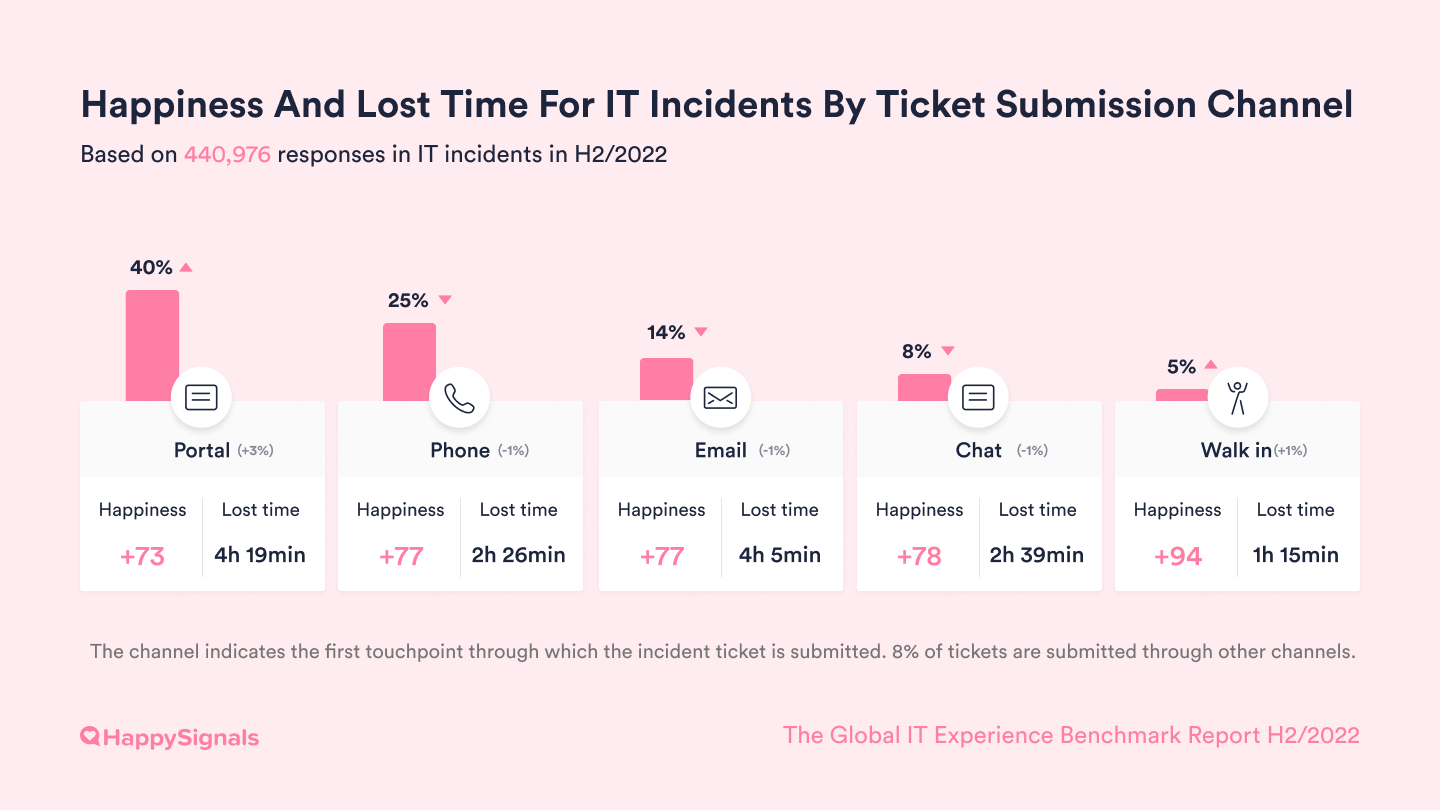
| Channel usage for IT Incidents | 2019 | 2020 | 2021 | 2022 |
| Chat | 8% | 9% | 9% | 9% |
| 19% | 17% | 15% | 15% | |
| Phone | 30% | 30% | 27% | 25% |
| Portal | 33% | 33% | 38% | 39% |
| Walk in | 6% | 3% | 3% | 4% |
| Other | 4% | 8% | 8% | 8% |
Each time a ticket is reassigned, end-user happiness decreases by nearly 8 points, and users lose an average of 1 hour and 49 minutes of work time, ranging from 0 to 4 reassignments. When a ticket is reassigned four times, it can result in a total loss of 9 hours and 23 minutes!
Our data, collected over the past four years, has shown consistent trends in the frequency of ticket reassignments and the corresponding impact on end-user happiness and lost time. These trends have remained relatively stable, with only minor variations, indicating that they are a reliable and consistent indicator of the impact of ticket reassignments on end-user satisfaction and productivity.
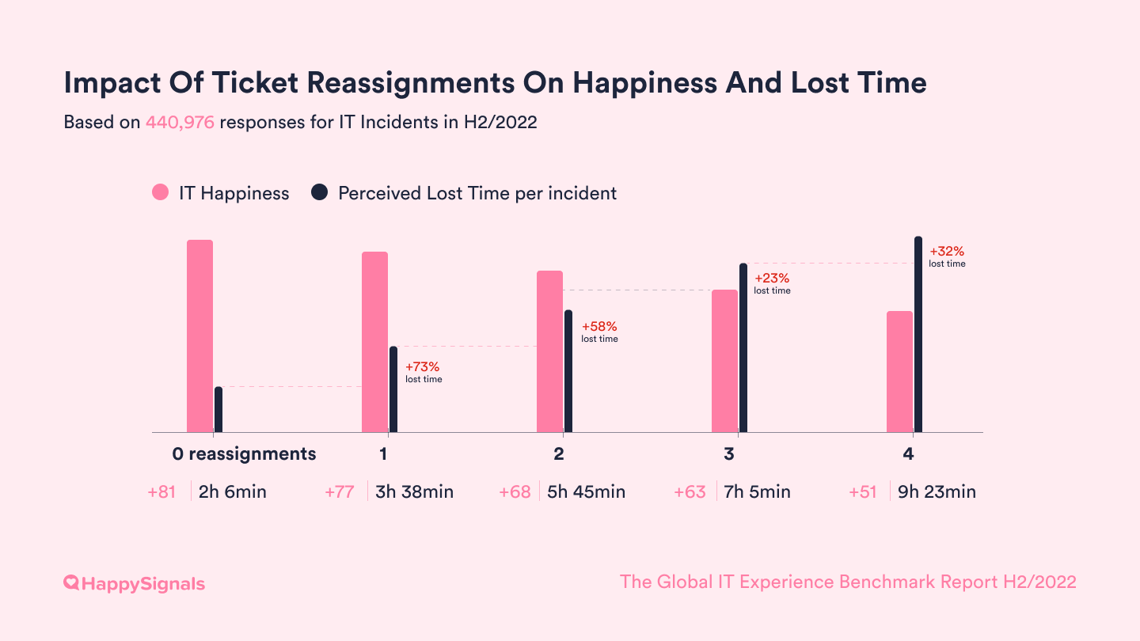
What is the business impact of ITXM on ticket reassignments?Understanding and improving ticket reassignments is crucial for IT to enhance end-user happiness and productivity, making it one of the most significant metrics. Begin by pinpointing the primary causes of ticket reassignments in your company. Determine which ticket types are bounced the most and the underlying reasons for it. Can modifications or automation be implemented to expedite the routing of these tickets to the appropriate agents? If you want to learn more about minimizing excessive ticket bouncing, refer to this article. Additionally, IT organizations can utilize HappySignals data on reassignments to create concrete business cases that demonstrate the potential productivity benefits that can be attained by implementing data-driven improvements aimed at reducing ticket reassignments.
|
5.5 Different Support Profiles have different service expectations
While we've covered the experiences of IT end-users in previous sections, it's important to note that there are also differences in behavior and motivation among them. Knowing these differences can help tailor IT services for different types of end-users.
This is where HappySignals IT Support Profiles can be useful.
We conducted interviews with over 500 end-users and found that two main behavioral drivers, Competence and Attitude, have the greatest impact on end-user behavior and experience. Competence refers to the end-user's capability to fix IT problems independently, while Attitude pertains to their willingness to solve the problem independently.
By mapping these behavioral drivers, we defined four Support Profiles: Doer, Prioritizer, Trier, and Supported. For more information on using these profiles in the IT Service Desk, refer to our Guide.
Consistent with previous years, Doers again have the lowest Happiness of +73, while Supported are still the happiest with Happiness of +84.
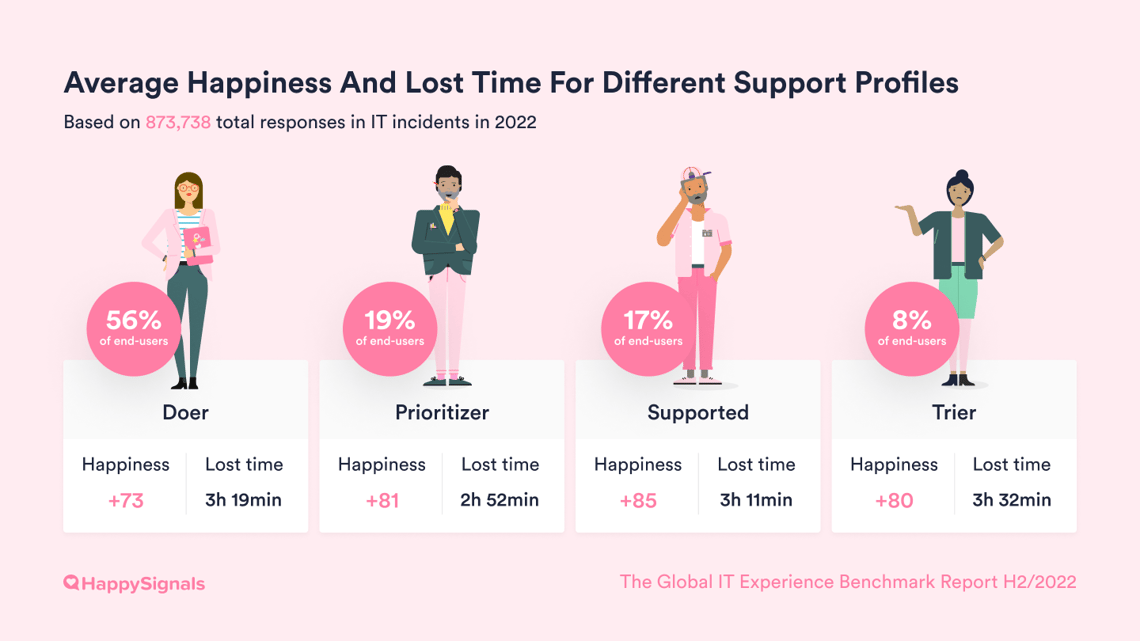
We have several hypotheses as to why these patterns have remained stable. One possible explanation is that the Doers, who are both competent and motivated to solve IT problems themselves, are likely to only raise tickets when faced with complex issues. These types of problems are typically more challenging for service agents to resolve quickly, making it difficult to achieve high experience scores with Doers. Additionally, as technically skilled end-users, they may have higher expectations for service quality and speed.
On the other hand, the Supported group is neither competent nor motivated to solve IT problems independently and are simply seeking assistance. They may be less demanding of IT services, resulting in higher satisfaction ratings on average. They may also submit tickets even for simple issues, which are easier for agents to resolve, leading to smoother service experiences.
Observing the way different support profiles utilize various channels confirms the behavioral drivers identified in our original research about IT Support Profiles. The data on IT incident channel usage by different profiles reveals the following patterns:
Self-service portals are the preferred channel for Doers, who enjoy solving issues themselves, and they are least likely to use the Phone.
Prioritizers, who prefer minimal participation in issue resolution, use the Phone more frequently than other support profiles.
Supported and Triers use Walk-in IT support 30-35% more often than Doers and Prioritizers, reflecting their preference for personal assistance and learning from patient service personnel.
For further information on how to customize services to better serve different end-users in the organization, we suggest downloading our Definitive Guide on IT Support Profiles.
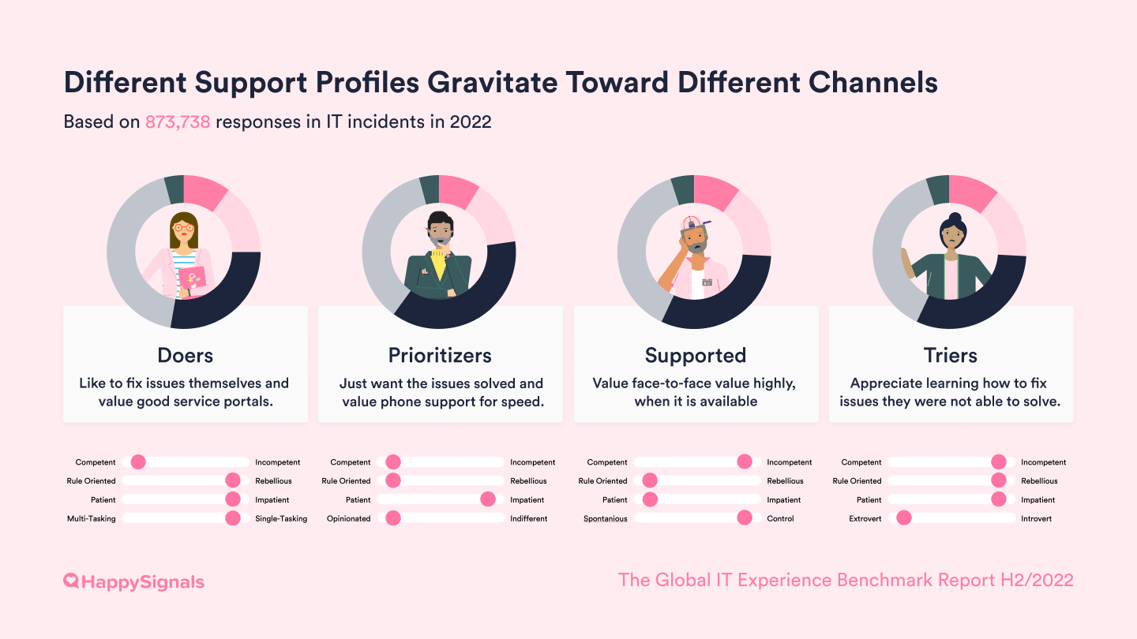
What is the business impact of understanding end-user IT Support Profiles?Although you can't change your end-users, you can customize your IT services to suit various support profiles. One way to do this is by adjusting how service agents communicate with each profile when they reach out to the service desk. For instance, Doers and Prioritizers may prefer technical jargon, while Supported and Triers may benefit from simple language and step-by-step instructions. Another approach is to analyze the data by profiles to identify which channels work best for different profiles. Then, you can develop and promote these channels to the relevant end-user profile groups. To learn more about using support profiles to enhance ticket-based services, check out our comprehensive guide!
|
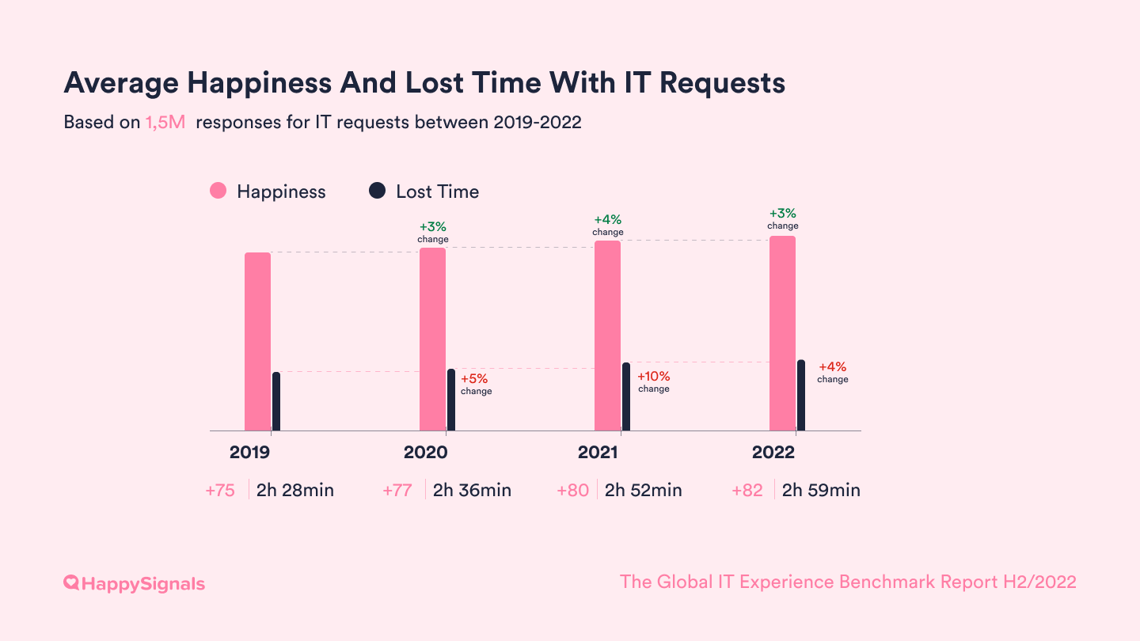
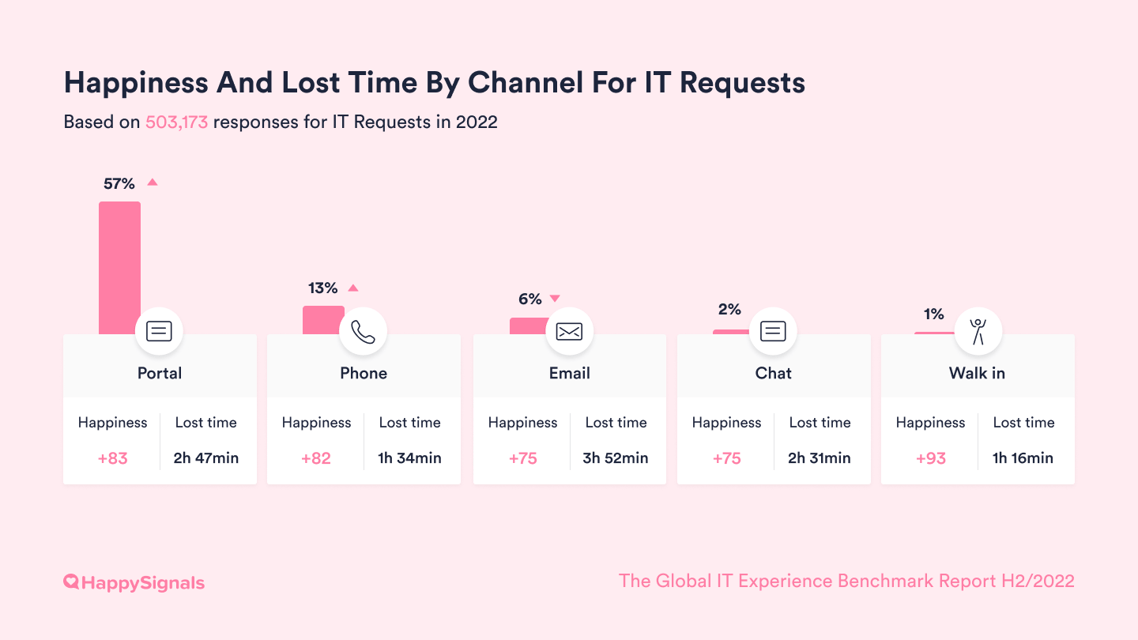
| Channel usage for IT Incidents | 2019 | 2020 | 2021 | 2022 |
| Chat | 1% | 2% | 3% | 2% |
| 8% | 8% | 9% | 6% | |
| Phone | 20% | 18% | 12% | 13% |
| Portal | 63% | 54% | 57% | 57% |
| Walk in | 1% | 2% | 1% | 1% |
| Other | 7% | 16% | 18% | 21% |
The saying “Technology changes, People stay the same” rings true in our data. The Factors that create positive, neutral and negative experiences with IT Requests for end-users remain very stable over the last 4 years.
The only slight changes have happened in a decrease in selection of service personnel's attitude and skills as factors, which could very well be explained by the increased amount of requests that don't require service personnel to intervene. Instead, requests are increasingly handled in self-service portals.
| IT Requests - Positive Factors | 2019 | 2020 | 2021 | 2022 |
| Speed of service | 79% | 79% | 80% | 80% |
| Service personnel's attitude | 49% | 48% | 47% | 45% |
| Service personnel's skills | 46% | 46% | 45% | 44% |
| I was informed about the progress | 31% | 34% | 36% | 34% |
| It was easy to describe what I wanted | 31% | 32% | 33% | 33% |
| Instructions were easy to understand | 29% | 31% | 32% | 32% |
| IT Requests - Neutral Factors | 2019 | 2020 | 2021 | 2022 |
| Speed of service | 58% | 57% | 58% | 56% |
| I had to explain my case several times | 15% | 15% | 15% | 15% |
| It was difficult to know where to start | 12% | 11% | 12% | 11% |
| I wasn't informed about the progress | 11% | 12% | 11% | 11% |
| It was difficult to describe what I needed | 8% | 8% | 8% | 9% |
| Instructions were hard to understand | 8% | 8% | 7% | 8% |
| Service personnel's skills | 7% | 6% | 6% | 7% |
| Service personnel's attitude | 5% | 4% | 6% | 6% |
| IT Requests - Negative Factors | 2019 | 2020 | 2021 | 2022 |
| Service was slow | 55% | 57% | 56% | 55% |
| I had to explain my case several times | 33% | 31% | 31% | 31% |
| I wasn't informed about the progress | 23% | 29% | 27% | 26% |
| Service personnel's skills | 17% | 16% | 13% | 13% |
| Instructions were hard to understand | 12% | 12% | 11% | 12% |
| It was difficult to know where to start | 10% | 10% | 10% | 10% |
| Service personnel's attitude | 8% | 9% | 8% | 8% |
| It was difficult to describe what I needed | 7% | 6% | 7% | 7% |
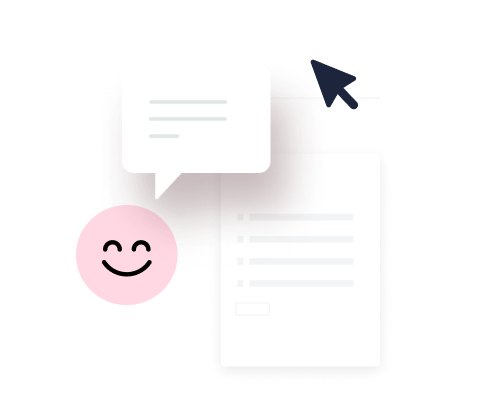
Intrigued? Discover experience management by reading the IT Experience Management Framework (ITXM™) Guide. This downloadable 10-page read introduces ITXM™ and how to lead human-centric IT operations with experience as a key outcome.
Do you prefer learning through short video courses? Check out ITXM.academy, where in about 1 hour, you can learn the foundations of IT Experience Management and get certified for free.
If you enjoyed this report, you may also want to visit our Learning Center for bite-sized videos and blog posts about topics from XLAs to optimizing your ServiceNow.

Read our previous Global IT Experience Benchmark Reports.
2022:
2021:
